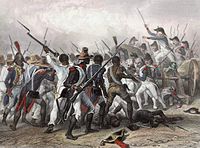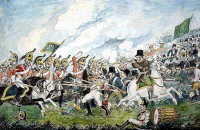Age of Revolution
This article needs additional citations for verification. Please help improve this article by adding citations to reliable sources. Unsourced material may be challenged and removed. Find sources: "Age of Revolution" – news · newspapers · books · scholar · JSTOR (November 2020) (Learn how and when to remove this template message) |
| Part of the Revolutions of 1820 Revolutions of 1830 Revolutions of 1848 End of feudalism Widespread implementation of Republicanism | |
| Deaths | American Revolution: 37,324+[1]
French Revolution: 150,000+[1] Napoleonic Wars: 3,500,000–7,000,000 (see Napoleonic Wars casualties) Over 3,687,324–7,187,324 casualties (other wars excluded) |
|---|---|
The Age of Revolution is a period from the late-18th to the mid-19th centuries during which a number of significant revolutionary movements occurred in most of Europe and the Americas.[2] The period is noted for the change from absolutist monarchies to representative governments with a written constitution, and the creation of nation states.
Influenced by the new ideas of the
The expression was popularized by the British historian Eric Hobsbawm in his book The Age of Revolution: Europe 1789–1848, published in 1962.[3]
Industrial Revolution
The Industrial Revolution was the transition to new manufacturing processes in the period from about 1760 to sometime between 1820 and 1840. It marked a major turning point in history and almost every aspect of daily life was influenced in some way. In particular, average income and population began to exhibit unprecedented sustained growth. This led to a rapid expansion of cities that resulted in social strains and disturbances.[4] For instance, economic grievances associated with this industrialization fed later revolutions such as those that transpired from 1848.[5] New social classes emerged including those that began to reject orthodox politics.[6] This is demonstrated by the rise of the urban middle class, which became a powerful force so that they had to be integrated into the political system.[7] The upheavals also led to old political ideas that were directed against the social arrangements of the preindustrial regime.[5]
American Revolution (1765–1783)

The American Revolution brought about independence for the Thirteen Colonies of British America. This was the first European colony to claim independence. It was the birth of the United States of America, ultimately leading to the drafting and ratification of a U.S. Constitution that included a number of original features within a federated republic and a system of separation of powers and checks and balances. Those include but are not limited to an elected head of state, property rights, due process rights, and the rights of free speech, the press and religious practice.[8][9][10]
French Revolution (1789–1799)

The French Revolution was a period of radical social and political upheaval in France from 1789 to 1799 that profoundly affected French and modern history, marking the decline of powerful monarchies and churches and the rise of democracy and nationalism.[11] Popular resentment of the privileges enjoyed by the clergy and aristocracy grew amidst an economic crisis following two expensive wars and years of bad harvests, motivating demands for change. These were couched in terms of Enlightenment ideals and caused the convocation of the Estates-General in May 1789.
The precipitating event was that the King went public that the French state was essentially bankrupt, and because of that he convened the États généraux (Estates general) to replenish state coffers. The Estates-General was made up of 3 estates/orders:
- 1st Estate: Clergy
- 2nd Estate: Nobility
- 3rd Estate: Wealthier, better educated non-nobility (commoners)[12][3]
King's weakened position
The French tax regime was regressive, and traditional noble and bourgeois allies felt shut out.
Centralizing monarchical power, i.e. Royal absolutism, onward from Louis XIII in 1614[12] inward to the royal court in Versailles led to a snowball effect that ended up alienating both nobility and bourgeoisie. There was a tendency to play favorites with the tax regime, especially by exempting nobility from taxation. This led to a feeling of discrimination among the bourgeoisie, which itself was an engine of the Revolution[13]
It was also a question of numbers. The population of nobles versus that of the rest of France wildly disparate: nobles = .4-1.5% out of total population of ca. 28 million. The population of clergy versus the rest of France was even less: about 120,000 clergy total, out of which were 139 powerful and wealthy bishops (.0005% of total pop.); the majority of parish priests were as poor as their parishioners.[14]
Bourgeoisie
These were young men from commoner families who were not sustenance farmers and whose families could afford to send their sons to either study the law or take over the family business. When talking about these young (mainly) lawyers from this segment of society, one is also talking about products of the Enlightenment. As the former Financial Times chief foreign affairs columnist and author Ian Davidson puts it:
"French society, like others in much of Western Europe, was undergoing a colossal transformation. The ultra-intellectual Enlightenment of Montesquieu and Voltaire, Bach and Mozart, Isaac Newton and Adam Smith was just the tip of a vast change that was happening throughout society and producing an expanding, educated, literate and ambitious bourgeoisie."[14]
Part of this ambition was to enter a political scene that was always locked behind a door to which only the monarchy, clergy, and nobility had the keys. The durable shift here was that, by the time the Estates general convened, their knowledge of law gave them the tools to enter the political scene.
Constitutional chronology
- Ancien Régime(pre–1789)
- National Constituent Assembly (1789–1791)
- Constitutional Monarchy(1791–1792)
- National Legislative Assembly(1791–1792)
- First Republic (1792–1804)
- National Convention (1792–1795)
- Directory(1795–1799)
- Consulate (1799–1804)
- First Empire, the reign of Napoleon (1804–1814)
Haitian Revolution (1791–1804)
This section does not cite any sources. Please help improve this section by adding citations to reliable sources. Unsourced material may be challenged and removed. (June 2020) (Learn how and when to remove this template message) |

The Haitian Revolution was a slave rebellion in the French colony of Saint-Domingue, which culminated in the elimination of slavery there and the founding of the Republic of Haiti. The Haitian Revolution was the only slave revolt which led to the founding of a state. Furthermore, it is generally considered the most successful slave rebellion ever to have occurred and as a defining moment in the histories of both Europe and the Americas. The rebellion began with a revolt of black African slaves in August 1791. It ended in November 1803 with the French defeat at the Battle of Vertières. Haiti became an independent country on January 1, 1804.
One-third of French overseas trade and revenue came from Haitian sugar and coffee plantations. During the French Revolution the island was ignored, allowing the revolt to have some initial successes. However, after Napoleon became the first consul of France, he sent troops to suppress the revolt.
The war was known for cruelty on both sides, and extensive guerrilla warfare. French forces showed no mercy, as they were fighting blacks, who were not considered to be worthy opponents of the French army.
The French army suffered from severe outbreaks of disease, and the Haitians were under-equipped. Top leaders of both sides were killed, and the leader of the Haitians died in captivity.
United Irishmen's Rebellion (1798)
This section does not cite any sources. Please help improve this section by adding citations to reliable sources. Unsourced material may be challenged and removed. (June 2020) (Learn how and when to remove this template message) |

In 1798, a revolt broke out against
Serbian Revolution (1804–1835)
The Serbian Revolution was a national uprising and constitutional change in
Scholars have characterized the Serbian War of Independence and subsequent national liberation as a revolution because the uprisings were started by broad masses of rural Serbian people who were in severe class conflict with the Turkish landowners as a political and economic masters at the same time, similar to Greece in 1821–1832.[15]
Latin American Wars of Independence (1808–1833)
This section does not cite any sources. Please help improve this section by adding citations to reliable sources. Unsourced material may be challenged and removed. (June 2020) (Learn how and when to remove this template message) |
Latin America experienced
Greek War of Independence (1821–1832)
This section does not cite any sources. Please help improve this section by adding citations to reliable sources. Unsourced material may be challenged and removed. (June 2020) (Learn how and when to remove this template message) |
Greece in the early 1800s was under the rule of the
Revolutions of 1820
This section does not cite any sources. Please help improve this section by adding citations to reliable sources. Unsourced material may be challenged and removed. (June 2020) (Learn how and when to remove this template message) |
The Revolutions of 1820 were a series of revolutionary uprisings in Spain, Italy, Portugal, and Greece. Unlike the wars of 1830, these wars tended to be in the outer regions of Europe.
Revolutions of 1830
A
Revolutions of 1848
The European Revolutions of 1848, known in some countries as the Spring of Nations, Springtime of the Peoples or the Year of Revolution, were a series of political upheavals throughout Europe in 1848. It remains the most widespread revolutionary wave in European history, but within a year, reactionary forces had regained control, and the revolutions collapsed.
The political impact of the 1848 revolutions was more evident in Austria in comparison to the revolution's effects in countries like Germany. This is attributed to the way the upheavals in Vienna resulted in greater loss of life and gained stronger support from intellectuals, students, and the working class.[18] An account described the German experience as less concerned with national issues, although it succeeded in breaking down class barriers.[18] There was a previously prevalent view that there was only one revolutionary event in Germany but recent scholarship pointed to a fragmented picture of several revolutions happening at the same time.[19]
The 1848 revolutions were also notable because of the increased participation of women. While women rarely participated in revolutionary activities, there were those who performed supportive and auxiliary roles such as the cases of the women's political club in Vienna, which demanded revolutionary measures from the Austrian Constituent Assembly, and the Parisian women who protested and proposed their own solutions to social problems, particularly those involving their rights and crafts.[20]
Eureka Rebellion (1854)
The Eureka Rebellion was a 20-minute shootout between the miners of
First War of Indian Independence (1857–1858)
The Indian Rebellion of 1857 was a major, but ultimately unsuccessful, uprising in India in 1857–58 against the rule of the
Bulgarian revolts and liberation (1869–1878)
Bulgarian modern nationalism emerged under Ottoman rule in the late 18th and early 19th century, under the influence of western ideas such as liberalism and nationalism, which trickled into the country after the French Revolution. In 1869 the Internal Revolutionary Organization was initiated. An autonomous Bulgarian Exarchate was established in 1870/1872 for the Bulgarian diocese wherein at least two-thirds of Orthodox Christians were willing to join it. The April Uprising of 1876 indirectly resulted in the re-establishment of Bulgaria in 1878.
Paris Commune (1871)
The
See also
- List of revolutions and rebellions
- Atlantic Revolutions
- Modern history
- Long nineteenth century
- Pax Britannica
- Political history of the world
- Risorgimento
- Timeline of national independence
- Revolutionary Spring: Fighting for a New World 1848–1849 by Christopher Clark
- Spanish American wars of independence
References
- ^ a b https://books.google.com/books?id=3KglCgAAQBAJ&pg=PA775 Archived 2022-12-03 at the Wayback Machine>
- ^ Matson, Cathy (July 2005). "The Atlantic Economy in an Era of Revolutions: An Introduction". William and Mary Quarterly.
{{cite journal}}: Cite journal requires|journal=(help) - ^ a b c Hobsbawm, Eric, The Age of Revolution: Europe 1789–1848, London, Abacus (1962).
- ISBN 9781610270854.
- ^ ISBN 9781680480283.
- ISBN 9780713165319.
- ISBN 9780006387503.
- ^ Robert A. Ferguson, The American Enlightenment, 1750–1820 (1997).
- ISBN 978-0495904991.
- ^ Wood, The American Revolution: A History (2003)
- ISBN 0860915468.
- ^ ISBN 9781681772509.
- ^ Id., pp. 2-3.
- ^ a b Id., pp. 4-5.
- ^ Cirkovic, Sima (2008). The Serbs. John Wiley & Sons. pp. 290–295.
- ^ Clive H. Church, "Forgotten Revolutions: recent work on the revolutions of 1830 in Europe." European Studies Review 7.1 (1977): 95-106.
- ^ Clive H. Church, Europe in 1830: Revolution and political change (1983)
- ^ ISBN 9780582357655.
- ISBN 0199249970.
- ISBN 0521839076.
- ^ 'Dr. H.V. Evatt, leader of the ALP, wrote that "The Eureka Stockade was of crucial importance in the making of Australian democracy"; Robert Menzies, later Liberal Prime Minister, said that "the Eureka revolution was an earnest attempt at democratic government"; Ben Chifley, former ALP Prime Minister, wrote that "Eureka was more than an incident or passing phase. It was greater in significance than the short-lived revolt against tyrannical authority would suggest. The permanency of Eureka in its impact on our development was that it was the first real affirmation of our determination to be masters of our own political destiny." (from "The Eureka Rebellion". National Republicans. Archived from the original on 8 March 2017., quoting Historical Studies: Eureka Supplement, Melbourne University Press, Carlton, Vic., 1965, pages 125–6)
- ^ Sunterass, Anne Beggs (2003). "Contested Memories of Eureka: Museum Interpretations of the Eureka Stockade". Labour History. History Cooperative. Archived from the original on 26 April 2007. Retrieved 22 December 2006.
- ^ Geoffrey Blainey commented in 1963 that "Eureka became a legend, a battlecry for nationalists. republicans, liberals, radicals, or communists, each creed finding in the rebellion the lessons they liked to see." ..."In fact the new colonies' political constitutions were not affected by Eureka, but the first Parliament that met under Victoria's new constitution was alert to the democratic spirit of the goldfields, and passed laws enabling each adult man in Victoria to vote at elections, to vote by secret ballot, to stand for the Legislative Assembly." Blainey, Geoffrey (1963). The Rush That Never Ended. Melbourne University Press. pp. 56–7.
